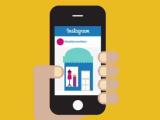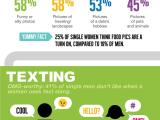Singles in America: Match Releases Its Fifth Annual Comprehensive Study on the Single Population
From emotions to emojis, findings reveal the ways in which technology is impacting courtship; additional insights shed light on sexual behaviors, gender roles & hot-button issues
.@Match #SinglesInAmerica 2014 includes singles' myths,
#dating dos/don'ts, and digital etiquette! Tweet
#dating dos/don'ts, and digital etiquette! Tweet
“According to the most recent census estimate, over a third of American adults are currently single—and after five years of interviewing them, my colleagues at Match and I have found definite patterns to how singles seek and find love, as well as their habits and attitudes,” said Dr. Helen Fisher, Match’s Chief Scientific Advisor. “Technology is dramatically changing how we court, but it can’t change the brain systems for romance and attachment. And today’s singles are setting a high bar for courtship and marriage. In fact, 34% of single men and 32% of single women believe it is ok to leave a ‘satisfactory marriage’ if you are no longer passionately in love. They want it all, and many believe they can get it all. I think they can, too.”
Key takeaways from this year’s study include:
ETIQUETTE FOR A NEW ERA
New technology and new media mean new habits and new rules
Where singles meet – 31% of U.S. singles met their last first date online, while 25% met through a friend and 6% of singles met their last first date in a bar or club.
Instant messages – 34% percent of 20-somethings expect a response within 10 minutes of sending a text, compared to 31% of 30-somethings, 27% of 40-somethings, 25% of 50-somethings and 14% of 60-somethings. Men want a faster connection than women – 30% of single men expect this immediate response compared to 26% of single women.
Texting turn-offs – Both single women (54%) and men (36%) find misspellings and incorrect grammar to be the biggest text message turn-offs, and 33% of single men don’t like “very short” text responses. Women don't want to receive sexts from men; men don’t want to receive texts during work; and singles don't want to receive a second text until after they have already responded to the first.
Social media taboos – The top social media activities that turn singles off include: airing your emotional drama in posts (65% men; 78% women); displaying too many selfies (46% men; 65% women); and asking you to un-friend your ex (49% men; 59% women). Also, 72% of singles do not want a potential partner to use their cell phone too frequently while on a date.
Selfie-centered – 53% of single women and 44% of single men have posted at least ONE selfie in the last year – to capture a moment (61% men; 67% women), to show off where they are and what they’re doing (42% men; 40% women), or to document a good hair day or outfit (19% men; 38% women). On Instagram, men are most turned on by pictures of a woman’s body (58%) and women are most turned off by pictures of men showing off their body (45%). Both genders are also turned on by funny/silly photos (55%) and travel/landscape photos (54%).
Sexts in all sizes – According to singles‘ BMI (body-mass index), underweight singles (26%), normal weight singles (34%), overweight singles (32%) and obese singles (32%) have all sent sexts.
So emojional – 51% of singles say they use emojis to give their texts ‘more personality’ and 37% say that emojis make it ‘easier to express their feelings.’ Single emoji-users regularly use the wink (53%), the smiley face (38%), and the kiss (27%) to flirt with a date. But limit yourself to only 1-3 emojis per text, please! Also, 52% of emoji-using singles went on at least one first date in 2014, compared to 27% of singles that never use emojis. Single emoji-users are also twice as likely (62%) as non-users (30%) to want to get married.
THE CLOONEY EFFECT
Or…the allure of Amal and the ‘new independent woman.’
End of the Macho Man – Like George Clooney, many men seek the "new woman" – someone who is smart, powerful and self-sufficient. 87% of single men would date a woman who makes ‘considerably more’ money and who is considerably better-educated and more intellectual than themselves; 86% seek a woman who is confident and self-assured, and 39% would also make a long-term commitment to a woman who is 10 or more years older.
What women want – Single women want: more time with friends (64% women; 55% men), more personal space (90% women; 78% men), their own bank account (78% women, 68% men); and to pursue their own hobbies and interests (93% women, 88% men). Single women are also slower to want to move in with a new partner, thus maintaining their independence. Single women are most likely to expect to date someone for 1-2 years before living together (33% women; 30% men), while single men are most likely to want to date 6-12 months before cohabitating (34% men; 23% women). Yet, 46% of singles believe the sexes are equally romantic.
Financially free – 51% of single women don’t care if a man makes as much money as they do, but 63% of single women would not date someone who has considerable debt.
LOVE AND THE SINGLE LIFESTYLE
An active lifestyle increases your chances of finding love and romance.
Sweat some to get some – 33% of singles that exercise 2-6 times a week had sex at least monthly in 2014, compared to only 20% of singles who rarely or never choose to exercise. Additionally, 50% of singles that exercise at least twice per week went on a first date in 2014, compared to only 29% of singles who say they rarely or never exercise.
CrossFit is the best fit – Those singles who work out at CrossFit gyms have more sex (45% had sex at least monthly or more in 2014); single cross-fitters also go on more dates (55% went on at least one date in 2014) than singles who work out in other ways.
But yogi men work it out – Single men who do yoga have had more sexual partners than those participating in any other kind of exercise. Yogi men aged 20-50 have had an average of 17 partners, while the average is 10 partners for men in this age group.
Fittest cities – Singles in Western states are the most likely to exercise at least 2-3 times per week (59%). The fittest cities include Portland and San Diego (64%).
The Single Vote
Singles makes up more than 1/3 of the U.S. adult population. Here’s where they fall on important issues.
Party lines – Singles identified themselves as belonging to of one of the following groups: Conservative Republican (8%), Moderate Republican (11%), Moderate Democrat (19%), Liberal Democrat (19%), Libertarian (2%), Independent (13%), or no stated political affiliation (27%).
Common ground – Single Democrats and Republicans surveyed agree on these three issues: the U.S. has a responsibility to aid allies in need (57% R, 54% D); Congress will continue to be ineffective without change (68% R, 69% D); governments should be limited in their access to private data (81% R, 76% D).
Take a stand – 75% of singles want their date to have an opinion on foreign and domestic news and events.
Singles’ values – Most singles believe in a woman’s right to choose (74% men; 81% women); in the legalization of marijuana (54% men; 48% women); in environmental protection laws (72% men; 76% women); and marriage rights for LGBT individuals (56% men; 60% women). Most singles also agree that they would vote for a single president (91% men; 90% women); and while 18% of singles don’t have an opinion on a presidential candidate’s gender, of those that do, a vast majority would vote for a female president (87% men; 95% women).
“This year we compared data for the online dater with that of the offline dater. It was interesting to see that online daters go on more dates, are more likely to be actively seeking a committed relationship, and are more likely to be employed full-time and are more educated,” said Amarnath Thombre, President of Match North America. “In 20 years, the perception of our category has changed dramatically and it reflects in who uses it today.”
For additional detailed findings on what U.S. singles are looking for in sex, love and romantic partnerships, visit www.SinglesinAmerica.com.
About Singles in America
Singles in America (SIA) was funded by Match.com and conducted by Research Now in association with renowned anthropologist Dr. Helen Fisher and evolutionary biologist Dr. Justin R. Garcia of The Kinsey Institute for Research in Sex, Gender and Reproduction at Indiana University. The 2014 study is based on the attitudes and behaviors taken from a representative sample of 5,675 U.S. singles between the ages of 18 to 70+, and remains the most comprehensive annual survey of single Americans. For more information, visit www.SinglesinAmerica.com.
About Match
Founded in 1995, Match was the original dating website and pioneer of the online dating industry. Today, 20 years later, Match operates leading subscription-based online dating sites in 25 countries, eight languages and five continents and is responsible for more dates, relationships and marriages than any other website. Match.com is an operating business of IAC (Nasdaq: IACI) and is headquartered in Dallas, Texas. For more information, visit http://www.match.com.
For more information:
Match: Alexis Ferraro, [email protected], 214-265-3039
DKC: Caitlin O’Neill, [email protected], 212-981-5246
Video
Infographic
Download
VideoDocument
SIA 2015 Navigating Digital DatingLinks
www.SinglesInAmerica.com








